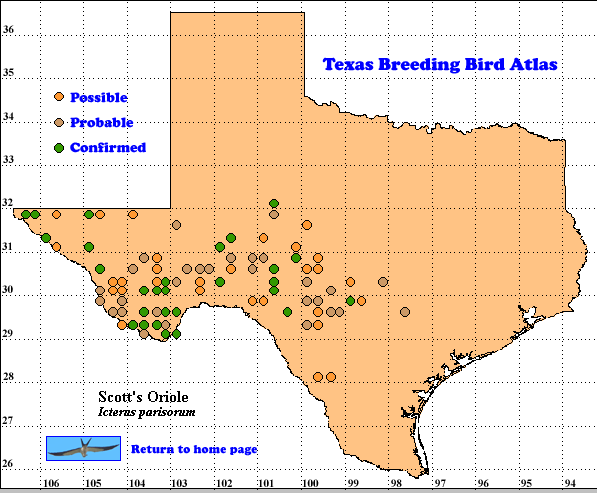Scott’s Oriole is an adaptable species, breeding in a number of Chihuahuan desert habitats in Texas. The species is primarily insectivorous, supplementing with fruit and nectar. The adult male’s black hood and back and lemon yellow underparts separate it from other common male orioles in this state. Visual identification of females and immatures requires experience and care (see Pyle [1997] and Flood [2002] for distinguishing characteristics). .
DISTRIBUTION. During the 1987-1992 field work for the TBBA project, observers found Scott’s Oriole breeding in the Trans-Pecos and Edwards Plateau regions (see map in Lockwood and Freeman [2004]). The highest relative abundances on Breeding Bird Survey (BBS) routes in Texas were along the Rio Grande River in Brewster County (10-30 observed per route) decreasing to 1-10 in most of the rest of the Trans-Pecos region and decreasing to 1-3 and then <1 going east across the Edwards Plateau region (Sauer et al. 2005)..
In other parts of its range the species breeds from California, Nevada, Utah and Colorado south through Arizona, New Mexico, Baja California and the highlands of mainland Mexico to the Isthmus of Tehuantepec. This oriole winters in Baja California Sur, along the west coast and in the central highlands of mainland Mexico (Howell and Webb 1995, Sauer et al. 2005).
SEASONAL OCCURRENCE. In spring migrant Scott’s Orioles arrive as early as March 25 (peak early April to mid May) to June 10. The breeding season extends from late April to mid-July, based on egg dates from May13 to June 21). Scott’s Oriole migrates south from mid-July to mid-October with some lingering as late as mid-December. There are a few scattered winter records (Oberholser 1974, Lockwood and Freeman 2004).
BREEDING HABITAT. In Texas Scott’s Oriole breeds from 360 m (1200 ft) to 2400 m (80000 ft) in juniper-oak, yucca flats and occotillo habitats (Oberholser 1974. In Arizona it also breeds across a broad elevational range in a wide variety of habitats from Sonoran desert scrub through desert grassland with scattered shrubs and cacti to higher elevation grassland with agave and yucca and pinyon-juniper (Corman 2005).
The nest is a sturdy basket of twisted, interlaced grasses (plucked green) and fibers of dead yucca leaves; lined with finer grasses, cottony material, and hair, all lashed to leaves of yucca. It is sometimes placed in the center of a mistletoe clump or in a pinyon pine or oak. The nest is usually 2.4-6 m (8-20 ft) above the ground. The inside diameter is 10 cm (4 in) and cup depth 9 cm (3.5 in).
The female usually lays 3 (range 2-4) pale bluish white eggs with no gloss (see Harrison [1979] for photo of markings). The female incubates the eggs about 14 days (Harrison 1979).
STATUS. Lockwood and Freeman (2004) rate Scott’s Oriole as an uncommon to common summer resident. The area of confirmed breeding sites on the TBBA map is generally similar to the area of summer and breeding records on Oberholser’s (1974) map BBS data from 40 km (25 mi) routes produce a 95% confidence interval (There is a 95% chance that the actual population trend will be between these two numbers.) for Texas of -2.0 to +6.7% population change per year for the period 1966-2004. Across the southwestern United States, data from 138 routes produce a 95% confidence interval of -1.1 to +2.7% population change (Sauer et al. 2005). These encouraging data suggest this attractive species will continue to delight birdwatchers in southwestern Texas for the foreseeable future. Text by Robert C. Tweit (2005)
 Literature cited.
Literature cited.
Corman, T. E. 2005.Scott’s Oriole (Icterus parisorum). In Arizona breeding bird atlas.p p. 574-575 (T. E. Corman and C. Wise-Gervais, eds.), University of New Mexico Press, Albuquerque.
Flood, N. J. 2002. Scott’s Oriole (Icterus parisorum). In The birds of North America, No. 608 (A. Poole and F. Gill, eds.). The Birds of North America, Inc., Philadelphia, PA.
Harrison, H. H. 1979. A field guide to western birds’ nests. Houghton Mifflin, Boston, MA.
Howell, S. N. G. and S. Webb. 1995. A guide to the birds of Mexico and northern Central America. Oxford University Press, New York.
Lockwood, M. W. and B. Freeman. 2004. The TOS handbook of Texas birds. Texas A&M University Press, College Station.
Oberholser, H. C. 1974. The bird life of Texas, Vol. 2. University of Texas Press, Austin.
Pyle, P. 1997. Identification guide to North American birds, part 1. Slate Creek Press, Bolinas, CA.
Sauer, J. R., J. E. Hines, and J. Fallon. 2005. The North American Breeding Bird Survey, results and analysis 1966-2004. Version 2005.1. USGS Patuxent Wildlife Research Center, Laurel MD (Web site, http://www.mbr-pwrc.usgs.gov/bbs).
